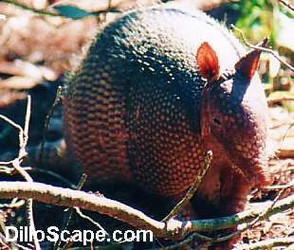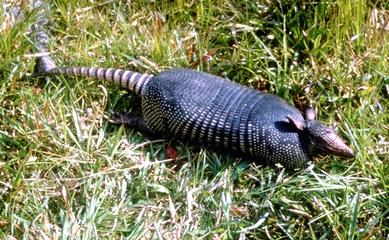About 130 million years ago, South America was cut adrift from what is now the west African coast line of the super-continent of Gondwanaland. (1) This giant island raft of South America was thus sucessfully isolated from the rest of the world, as were the animals that lived there, during most of the period of mammal evolution. This was a time when many Mammals were evolving from smaller animals to a larger and more diversified group. Due to this extended period of geographic separation, which ended about three million years ago when the Americas touched, South America has produced some very unique plants and animals. This is where we meet the Xenarthrans. The group of mammals called the Xenathrans include sloth, anteaters, several extinct species and the armadillo. (2) This is the story of the armadillo.


Dasypodidae. © Regents of the University of Michigan and its licensors.
First, a short taxonomic breakdown of what it means to be an armadillo. Taxonomy is a system for classifying organisms, the Linnaean system being the one currently used by taxonomists. Created by Swedish biologist Carolus Linnaeus, it starts with very broad catagories and moves into more specific detail with each division. These classifications can tell us about how closely related different organisms are, and give a greater understanding of the big evolutionary picture. (3)
The armadillo belongs to the Kingdom Animalia and the Phylum Cordata. On the most fundamental level this means that they are not bacteria, plants, fungus or protists. These other animal Kingdoms diverged a long time ago, way before the Xenathrans came on the scene. The armadillo and animals like it evolved to have a backbone, or spinal column, which further differentiates them from other animal kingdom phyla that do not, such as worms, jelly fish, sponges etc. Like most other animals (all except sponges) the armadillo body is made up of cells organized into tissues. Each tissue has been specialized to perform specific functions, and in most animals these tissues are organized into organs that are even more specialized. Animals of this kind, reproduce sexually by means of differentiated eggs and sperm, and are diploid, which means that the adult cells carry two copies of genetic material. The members of this kingdom are all multi-cellular heterotrophs, meaning that they rely directly or indirectly on consuming other organisms for food.(4)


Dasypodidae. © John Niehaus. Webmaster, DilloScape.com
Animals in the Phylum Chordata evolved to show bilateral symmetry, meaning that their left half looks pretty much like their right. Like other higher and intermediate animals, the armadillo arises from a triploblastic ovum. This basically means that they have the three distict cell or “germ” layers that diferentiate all protostomes and deuterostomes from the simpler animal groups that diverged from them. These simpler groups have only one or two germ layers. For example, armadillos and other mammals have three germ layers (triploblasts) as compared to jelly fish with two germ layers (diplobasts) and sponges with only one layer. From one of these three tissue layers a coelom is formed. A coelom is essentially a cavity that contains this animal type’s internal organs. It is a fluid filled sac that allows organs to grow independently of the animals body wall. It also functions as a protective layer and to hold the animals organs in a particular order. (5)
The next refining distinction we can make is that the armadillo belongs to the Class Mammalia. Mammalia, or mammals, can be generally characterized by the presence of hair or fur, milk secreting glands in females, fat glands and most species also have sweat glands. In addition, they have endothermic (warm blooded) bodies, teeth of different size/function, and a four chambered heart. The mammal groups living today are monophyletic, meaning they are all descendants of a common ancestor. They have, however, have evolved in three different ways:the placentals- who give live birth to their young after nourishment in the mother’s womb, the marsupials, like opossum and kangaroos, who give live birth to premature embryos that actually climb into the mother’s pouch where they continue to develop, and the monotremes, like the platypus, that lay eggs. The armadillo, like most of the mammal species alive today are placentals (Subclass Eutheria). Since armadillos and humans are both placental mammals, is it reasonable to say that they are closely related? Not really. There is great diversity even within one mammal subclass. Eutheria includes over 4000 living species of different shapes, sizes, and habitats. To really get to know the armadillo, even greater distinction must be made. (13)
A further defining quality is that the armadillo belongs to the Super Order Xenarthra-Order Cingulata. Xenathara is a small branch of mammals that first evolved around 50 million years ago. Their distinguishing attribute is called the xenarthrous process, which is a small bone spur on the lumbar verebrae that assists in stiffening the spine. The earliest armadillo like creatures were relatively large compared with modern species. They were the car-sized glyptodon and panocthus. Since South America America was still essentially a big island at that time, they were still isolated from the rest of the world, and in this environment they florished. With their bony body armor, they were relatively safe from predators, until the land bridge developed between the Americas. Large feline and canine predators moved southward and the armadillo populations were not unaffected, despite their bone shells. The fossil record indicates that around seventy precent of the indigenous South American mammals went extinct at this time. The armadillo is the only suriving family of the Order Cingulata, which is yet another division that differentiates animal types. Five exinct families in this order are know only from the fossil record. (3
The amadillo family (Dasypodidae) is the most diverse of the Xenarthrans, (11) and the final word in armadillo description is a Linnaean system combination of the animal’s 8 different genera and 20 species.
The species of armadillo alive today range in color from pink or gray to brownish black. They are about the size of a cat,(except for the giant armadillo which can weigh up to 130lbs.) but have four very short, strong legs making them well built to dig (and dig they do!) They also have strong claws that equip them to tear open logs or ant nests to eat the bugs inside. Armadillos are the only mammals that have shells. It is made of true bone, that cover their backs and most also have bony rings or plates that protect their tails. Because their backs are covered with bone, armadillos are not very flexible.One species — the three-banded armadillo — can roll itself into a ball for protection, though it is thought that this is the only armadillo species that can to this. (3)Their bellies are are not armored but are instead covered with bristly hair. Their eyes are small, their eyesight poor, and they do not have color vision. Since their food is never more than a few inches away, it would seem that their eyes have not really needed to evolve much. They do, however, have an excellent sense of smell which enables them to locate worms or grubs up to eight inches under ground. (7) Because small bugs and soft plants are not difficult to chew, armadillos do not have very complicated teeth and they have lost all but their molars over time.
Armadillos are ominvores and have sticky saliva and a long sticky tongue, that allows them to gather insects from fallen logs and the ground. They will also use their legs to dig into the ground for food. The Armadillo’s diet consists of numerous kinds of bugs, worms, grubs, spiders, small mammals, fruit, berries, amphibians, small reptiles, plant matter, and snails. They will also eat ground-nesting birds, and the eggs of quail and turkey. (12)
Armadillo mating is usually in the summer months with a gestation period (the time from conception to birth) between two and nine months, but this varies with species. Most have one or two offspring, though some species have four. (3)
The Armadillo is found from South America to the south-central and southeastern United States. It has also been found on the islands of Grenada, Trinidad and Tobago. They can live in a variety of habitats but are usually found in forest near marshy regions.(12)Within their natural historic setting, the armadillo seems to have a copacetic, if not necessarily symbiotic relationship with its environmental community. Since 75% of the armadillo diet is short life cyle insects, the armadillos feeding habits seems to have little effect on the prey population. However, diminishing habitat size has resulted in the armadillo being considered a pest in some areas where they are known to dig up lawns, flower beds, crop fields etc., looking for bugs, and making the undergound burrows that they call home. These burrows can be up to 20 feet in length and often have several entrances. Although the armadillo can count wolves, bears, coyotes and wild cats among it’s natural predators, the real danger is from cars, dogs and humans. Some Armadillo species are precariously close to human caused extinction, while other species have relatively high population numbers.(3) Let us hope this interesting little animal does not ever join the ranks of so many others: surviving only in zoos, or worse yet- in text and photo essays of species now departed.
Challenge questions! Armadillos seem to really love to dig. They dig for food and dig underground burrows with multiple entrances-more, it appears, than are actually needed. In addition to occupied burrows, it is not unusual to find burrows that are usually uninhabited but used occasionally. (Armadillo time shares?) Some species have particular burrows just for mating and other burrows to live in. Few animals of their size have so many dens per individual as the armadillo. In Texas, wildlife biologists have researched burrows and “found some up to 15 feet in length, complete with curves and many rooms.” (14) Armadillos are build to dig and seem to have the biological drive (extended phenotype) to do it. Their ability to dig and the behavioral phenotype that tell them to do has been a useful survival adaption. They need to find food and live somewhere. Arguably, selective pressures and unknown variable notwithstanding, it seems as if the armadillo continues to dig even when it doesn’t need to. Armadillo are primative mammals with very small brains. They most certainly don’t have likes and dislikes the way a human does but is it possible that the armadillo may sometimes dig for its own rudamentary version of fun? Are there other species that show extended phenotypes that seem to reach beyond survival to the point of enjoyment, or is it just uncontrolled biological drive?
No armadillos where harmed during the creation of this manuscript.


Dasypodidae. © Regents of the University of Michigan and its licensors.




 Go to quick links
Go to quick search
Go to navigation for this section of the ToL site
Go to detailed links for the ToL site
Go to quick links
Go to quick search
Go to navigation for this section of the ToL site
Go to detailed links for the ToL site